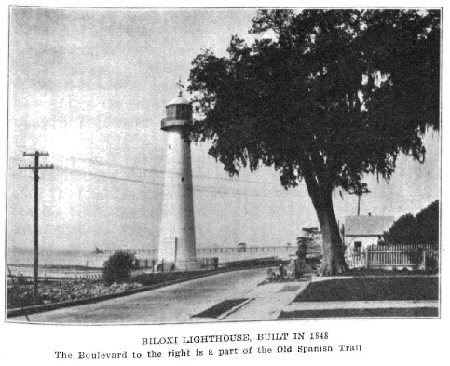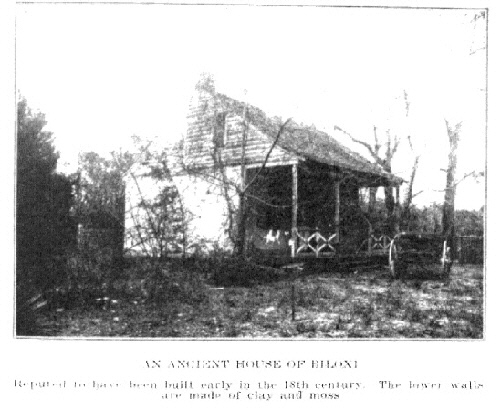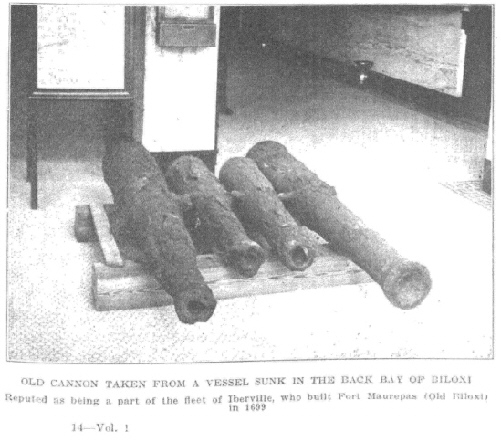.
Harrison
County

HARRISON COUNTY
Chapter XLV, pages 731-731
Harrison County is one of the three gulf
counties of Mississippi and was created on February 5, 1841, with the following
described limits: "Beginning at the point where the line dividing ranges
13 and 14 strikes the bay of St. Louis, then with said line due north to
the northern boundary of township 3, south, thence due east to the center
of range 9; thence south to the bay of Biloxi; thence southeast to the
point of Caddi; thence westwardly with the seashore and the shore of the
bay of St. Louis to the beginning." The tier of townships in Perry County,
which adjoined Harrison on the north, were added to the county January
24, 1844. It took its name in honor of Gen. William Henry Harrison, then
President of the United States. Its early history is embodied in that of
Hancock and Jackson counties, from which it was principally formed.
In 1916 most of the northern half of Harrison
County was taken to form the new county of Stone, which reduced its area
to 570 square miles.
Biloxi is a coast city situated about midway
between New Orleans and Mobile, and is one of the most important cities
between those centers. It is historically the oldest town in the State
and was settled by the French in 1721, being the capital of the Province
of Louisiana until 1722, when Bienville, then Governor, decided to move
the capital to New Orleans. It is a noted winter resort, while commercially,
the city has grown from a place of only 1,500 inhabitants, thirty-five
years ago, to a place of over 10,000 people today, with extensive manufacturing
and shipping interests. It probably leads the world in the canning of oysters
and shrimps and in the value of those products shipped in the raw state.
Harrison County is primarily industrial, and has more than 80 establishments
of that character, which distribute over $2,000,000 in wages and have an
output valued at $6,500,000. Of the latter amount Biloxi contributes nearly
$2,000,000. Within the past twenty years, the city has more than doubled
in population. In 1900, it had 5,467 people; in 1910, 8,049 and in 1920,
10,937.

Four miles west of Biloxi, on the beach,
stands Beauvoir, the picturesque old home of Jefferson Davis, where he
lived during his declining years. It is now utilized as a home for Mississippi’s
Confederate veterans and is supported by a State appropriation. There is
a rumor to the effect that it will be converted into a college in some
future day for the descendants of Confederate veterans.
Gulfport, the flourishing county seat,
is at the terminus of the Gulf & Ship Island railroad, and, through
the efforts of Capt. J.T. Jones and the Federal Government, a fine ship
basin has been constructed, connected by a channel with the harbor off
Ship Island, only seven miles away. Gulfport is therefore a seaport, and
since 1900 has increased in population from 1,000 to 8,000.

[AN ANCIENT HOUSE OF BILOXI
Reported to have been built
early in the 18th century. The lower walls
are made of clay and moss]
Other important coast towns are Pass Christian,
with a population of 2,300 in 1920, and famed as a health resort and for
its beautiful shell roads; Mississippi City, the old capital, and also
both a summer and a winter resort, and Handsboro and Long-beach, on the
line of the Louisville & Nashville railroad. A chain of small cities
and towns along the Gulf Coast are linked together by electric car lines,
and with a denser population would make the largest city in area in the
South.

[OLD CANNON TAKEN FROM A
VESSEL SUNK IN THE BACK BAY OF BILOXI
Reputed as being a part
of the fleet of Iberville, who built Fort Maurepas (Old Biloxi)
in 1699]
The important water courses of the county
are the Big and Little Biloxi rivers, which, with their numerous tributaries,
are utilized in carrying on the large and growing lumber industry of the
region. It is not a typical agricultural county, although vegetables are
readily grown and are a source of considerable profit. In fact, of the
total value of the county’s crops, $672,000, the truck gardens and farms
realized an income of $319,000. The region around Biloxi is especially
productive in this regard. Peaches and apples, grapes, figs and nuts are
more typical of Harrison County than the cereal crops. As a producer of
nuts, the county leads all the other sections of the State, its 9,000 bearing
trees yielding 157,000 pounds in 1919.
Return to
County History Index
MSGenWeb Home
Source:
Mississippi The Heart of the South - By Dunbar Rowland, LL.D - Director
of the Mississippi State Department of Archives and History. Vol.
II Illustrated. Chicago-Jackson; The S. J. Clarke Publishing
Company, 1925. Public Domain
Copyright Notice: All files
and photographs on this site are copyrighted by their creator and/or contributor,
unless otherwise noted. They may be linked to but may not be reproduced
on another site without specific permission from The MSGenWeb State Coordinator
or the Assistant State Coordinator, and/or their contributor. Although
public information is not in and of itself copyrightable, the format in
which they are presented, the notes and comments, etc., are. It is however,
quite permissible to print or save the files to a personal computer for
personal use ONLY.
  
|







